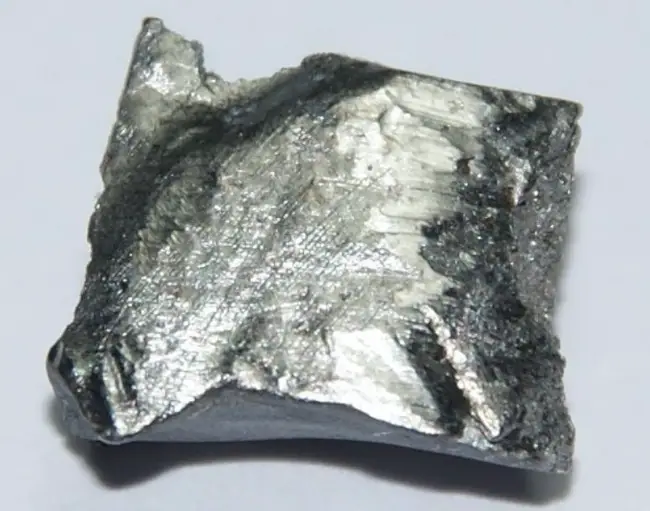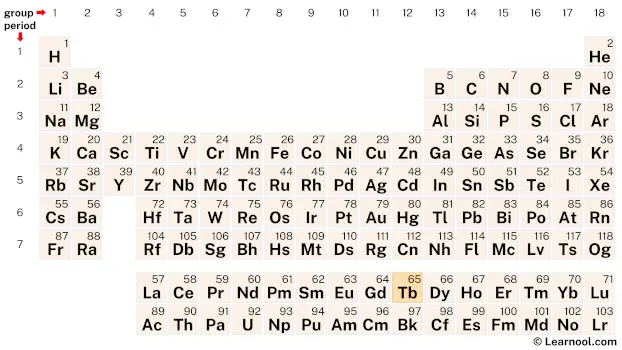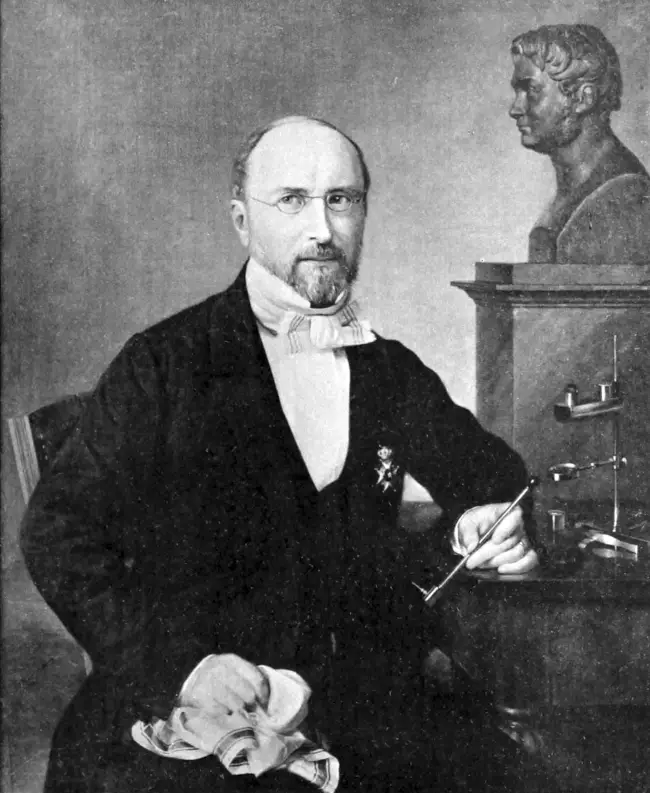
Terbium (Tb) is a chemical element of the periodic table, located in the period 6, and has the atomic number 65. It is the ninth element in the lanthanide series. It is a malleable, ductile, silvery-white metal, which is named after Ytterby, a village in Sweden, where it was mined. It is never found freely in nature and is counted as one of the rare earth elements.
On periodic table
| group | ⇨ | 1 | 2 | 3 | 4 | 5 | 6 | 7 | 8 | 9 | 10 | 11 | 12 | 13 | 14 | 15 | 16 | 17 | 18 |
| period | ⇩ | ||||||||||||||||||
| 1 | 1 H  Hydrogen |
2 He  Helium |
|||||||||||||||||
| 2 | 3 Li  Lithium |
4 Be  Beryllium |
5 B  Boron |
6 C  Carbon |
7 N  Nitrogen |
8 O  Oxygen |
9 F  Fluorine |
10 Ne  Neon |
|||||||||||
| 3 | 11 Na  Sodium |
12 Mg  Magnesium |
13 Al  Aluminium |
14 Si Silicon |
15 P  Phosphorus |
16 S  Sulfur |
17 Cl  Chlorine |
18 Ar  Argon |
|||||||||||
| 4 | 19 K  Potassium |
20 Ca  Calcium |
21 Sc  Scandium |
22 Ti  Titanium |
23 V  Vanadium |
24 Cr  Chromium |
25 Mn  Manganese |
26 Fe  Iron |
27 Co  Cobalt |
28 Ni  Nickel |
29 Cu  Copper |
30 Zn  Zinc |
31 Ga  Gallium |
32 Ge  Germanium |
33 As  Arsenic |
34 Se  Selenium |
35 Br  Bromine |
36 Kr  Krypton |
|
| 5 | 37 Rb  Rubidium |
38 Sr  Strontium |
39 Y  Yttrium |
40 Zr  Zirconium |
41 Nb  Niobium |
42 Mo  Molybdenum |
43 Tc  Technetium |
44 Ru  Ruthenium |
45 Rh  Rhodium |
46 Pd  Palladium |
47 Ag  Silver |
48 Cd  Cadmium |
49 In  Indium |
50 Sn  Tin |
51 Sb  Antimony |
52 Te  Tellurium |
53 I  Iodine |
54 Xe  Xenon |
|
| 6 | 55 Cs  Caesium |
56 Ba  Barium |
72 Hf  Hafnium |
73 Ta  Tantalum |
74 W  Tungsten |
75 Re  Rhenium |
76 Os  Osmium |
77 Ir  Iridium |
78 Pt  Platinum |
79 Au  Gold |
80 Hg  Mercury |
81 Tl  Thallium |
82 Pb  Lead |
83 Bi  Bismuth |
84 Po  Polonium |
85 At  Astatine |
86 Rn  Radon |
||
| 7 | 87 Fr  Francium |
88 Ra  Radium |
104 Rf  Rutherfordium |
105 Db  Dubnium |
106 Sg  Seaborgium |
107 Bh  Bohrium |
108 Hs  Hassium |
109 Mt  Meitnerium |
110 Ds  Darmstadtium |
111 Rg  Roentgenium |
112 Cn  Copernicium |
113 Nh  Nihonium |
114 Fl  Flerovium |
115 Mc  Moscovium |
116 Lv  Livermorium |
117 Ts  Tennessine |
118 Og  Oganesson |
||
| 57 La  Lanthanum |
58 Ce  Cerium |
59 Pr  Praseodymium |
60 Nd  Neodymium |
61 Pm  Promethium |
62 Sm  Samarium |
63 Eu  Europium |
64 Gd  Gadolinium |
65 Tb Terbium |
66 Dy  Dysprosium |
67 Ho  Holmium |
68 Er  Erbium |
69 Tm  Thulium |
70 Yb  Ytterbium |
71 Lu  Lutetium |
|||||
| 89 Ac  Actinium |
90 Th  Thorium |
91 Pa  Protactinium |
92 U  Uranium |
93 Np  Neptunium |
94 Pu  Plutonium |
95 Am  Americium |
96 Cm  Curium |
97 Bk  Berkelium |
98 Cf  Californium |
99 Es  Einsteinium |
100 Fm  Fermium |
101 Md  Mendelevium |
102 No  Nobelium |
103 Lr  Lawrencium |
|||||
| – f block |
Terbium is found in the lanthanide series, a group of elements located at the bottom of the periodic table. Specifically, in period 6, between gadolinium (Gd) and dysprosium (Dy).
Element information
 |
|
 |
|
| Origin of name | named after Ytterby, a village in Sweden |
| Symbol | Tb |
| Atomic number (Z) | 65 |
| Atomic mass | 158.92535 u |
| Block | f-block |
| Period | 6 |
| Classification | Lanthanide |
| Atomic radius | 177 pm |
| Covalent radius | 194±5 pm |
| Melting point | 1356 ℃, 2473 ℉, 1629 K |
| Boiling point | 3123 ℃, 5653 ℉, 3396 K |
| Electron configuration | [Xe] 4f9 6s2 |
| Electrons per shell | 2, 8, 18, 27, 8, 2 |
| Crystal structure | Hexagonal close-packed (hcp) |
| Phase at r.t | Solid |
| Density near r.t | 8.23 g/cm3 |
| Main isotopes | Terbium-159 |
| Natural occurrence | Primordial |
| Oxidation state | +3 |
| Electronegativity (Pauling scale) | 1.2 |
| Protons Neutrons Electrons |
65 94 65 |
| CAS number | 7440-27-9 |
| Discovered by | Carl Gustaf Mosander in 1843 |
History

Terbium was first discovered in 1843 by Swedish chemist Carl Gustaf Mosander. While analyzing the rare earth elements yttria, erbia, and terbia, Mosander detected terbium as an impurity in yttrium oxide.
Originally, terbia was named for the fraction that contained a pink color, which was later found to be due to erbium. Erbia, which is now known as terbium, was the fraction that was essentially colorless in solution. However, due to a mix-up of the names of the fractions, the pink fraction came to refer to the solution containing erbium, which is pink in solution.
Terbium’s isolation in pure form was not achieved until ion exchange techniques were developed. The 19th century investigators did not have access to UV fluorescence technology, which would have made it easier to identify terbium in solid mixtures or solutions based on its brilliant yellow or green fluorescence.
Today, terbium has a variety of uses, including in the production of green phosphors used in color TV tubes, fluorescent lamps, and energy-saving lamps. It is also used in sonar systems and as a dopant in solid-state devices, such as lasers and magneto-optic storage devices. Terbium has no known biological role and is considered to be mildly toxic.
Occurrence and production
Terbium is a relatively rare element, found in the Earth’s crust at an abundance of approximately 1.2 parts per million. It occurs in several minerals, including monazite, xenotime, and euxenite. These minerals contain varying amounts of terbium, depending on their source.
Production of terbium involves extracting it from these minerals, which are typically found in small deposits around the world. The primary method of extracting terbium is through ion exchange or solvent extraction processes. These methods involve dissolving the mineral in acid and then separating the rare earth elements through a series of chemical reactions.
Once separated, terbium is typically purified further using techniques such as precipitation, ion exchange, or electrolysis. The resulting terbium oxide can then be converted into other forms, such as terbium metal or terbium alloys, for use in various applications.
The production of terbium is relatively small compared to other rare earth elements, with only a few hundred metric tons produced each year. Its limited availability and unique properties make it a valuable material in a variety of industries, including electronics, lighting, and green energy technologies.
Properties
Terbium is a soft, malleable, silvery-white metal that belongs to the lanthanide series of elements.
It has a relatively high melting point of 1356 ℃ and a boiling point of 3123 ℃.
Terbium is paramagnetic, meaning that it is weakly attracted to magnetic fields, and is also a ferromagnetic material below 219 K.
It has a hexagonal close-packed crystal structure and is relatively stable in air.
Terbium is also known for its high index of refraction, which makes it useful in the manufacture of special optical glass.
It is also used as a dopant in solid-state devices, such as semiconductors and phosphors, due to its fluorescence and phosphorescence properties.
Terbium is also a good neutron absorber, making it useful in nuclear reactors for controlling the rate of nuclear fission.
Applications
Lighting
Terbium is used in fluorescent lamps and tubes, as well as in some LED lighting products. When terbium is combined with other materials, it can produce a bright green or yellow glow, which is ideal for energy-efficient lighting.
Magnets
Terbium is used in the production of powerful magnets, particularly those used in wind turbines, hybrid cars, and other advanced technologies. Terbium is often combined with other rare earth metals, such as neodymium, to create the strongest possible magnetic field.
Imaging
Terbium is used in medical imaging technologies, such as MRI and CT scans. When terbium is combined with certain dyes or other materials, it can enhance the contrast in medical images, making it easier for doctors to identify and diagnose certain medical conditions.
Nuclear reactors
Terbium can be used as a control rod material in nuclear reactors, helping to regulate the rate of nuclear fission and prevent meltdowns or other accidents.
Other applications
Terbium is also used in other applications, such as in the production of superconducting materials, glass polishing powders, and alloys used in electronic devices.
Interesting facts
Terbium is named after the village of Ytterby in Sweden, where it was discovered.
Terbium is a rare earth element and is one of the least abundant of the lanthanides.
Terbium has the highest magnetic moment of any naturally occurring element, which makes it useful in magnetic alloys.
Terbium is also used in some electronic devices, such as fluorescent lamps and color television tubes.
Terbium can also be used as a dopant in fiber optic amplifiers and as a radiation source in portable X-ray machines.
Terbium is not toxic, but its compounds should be handled with care due to their potential radioactivity.
Terbium has a strong green emission that is used in some applications such as green laser pointers.
Terbium is also used in nuclear medicine, specifically in imaging and therapy for certain cancers.
Related
More elements
External links
- https://www.rsc.org/periodic-table/element/65/terbium
- https://en.wikipedia.org/wiki/Terbium
- https://www.britannica.com/science/terbium
- https://www.chemicool.com/elements/terbium.html
- https://pubchem.ncbi.nlm.nih.gov/element/Terbium
- https://www.livescience.com/38251-terbium.html
Deep
Learnool.com was founded by Deep Rana, who is a mechanical engineer by profession and a blogger by passion. He has a good conceptual knowledge on different educational topics and he provides the same on this website. He loves to learn something new everyday and believes that the best utilization of free time is developing a new skill.
